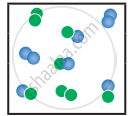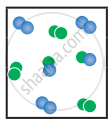Advertisements
Advertisements
प्रश्न
The equilibrium for the dissociation of XY2 is given as,
\[\ce{2 XY2 (g) <=> 2 XY (g) + Y2 (g)}\]
if the degree of dissociation x is so small compared to one. Show that 2 Kp = PX3 where P is the total pressure and Kp is the dissociation equilibrium constant of XY2.
उत्तर
\[\ce{2 XY2 (g) <=> 2 XY (g) + Y2 (g)}\]
| XY2 | XY | Y2 | |
| Initial no. of. moles | 1 | - | - |
| No. of. moles dissociated | x | - | - |
| No. of. moles at equilibrium | (1 - x) 1 | x | `"x"/2` |
Total no. of moles = `1 - x + x + x/2 = 1 + x/2 ≅ 1`
[∵ Given that x << 1; 1 - x ≅ 1 and 1 + `x/2` ≅ 1]
`"K"_"p" = (["P"_"xy"]^2["P"_("Y"_2)])/["P"_("XY"_2)]^2`
`= ((x/1 xx "P")^2((x//2)/1 xx "P"))/(1/1 xx "P")^2`
`"K"_"P" = (x^2"P"^2 xx "P")/(2"P"^2)`; 2Kp = x3P
APPEARS IN
संबंधित प्रश्न
In the equilibrium,
\[\ce{2A(g) <=> 2B(g) + C2(g)}\]
the equilibrium concentrations of A, B and C2 at 400 K are 1 × 10–4 M, 2.0 × 10–3 M, 1.5 × 10–4 M respectively. The value of KC for the equilibrium at 400 K is
For the reaction \[\ce{AB(g) <=> A(g) + B(g)}\], at equilibrium, AB is 20 % dissociated at a total pressure of P, the equilibrium constant Kp is related to the total pressure by the expression
For the formation of Two moles of SO3(g) from SO2 and O2, the equilibrium constant is K1. The equilibrium constant for the dissociation of one mole of SO3 into SO2 and O2 is
\[\ce{[CO(H2O)6]^2+ (aq) (pink) + 4Cl- (aq) <=> [CoCl4]^2- (aq) (blue) + 6 H2O (l)}\]
In the above reaction at equilibrium, the reaction mixture is blue in colour at room temperature. On cooling this mixture, it becomes pink in color. On the basis of this information, which one of the following is true?
For a given reaction at a particular temperature, the equilibrium constant has a constant value. Is the value of Q also constant? Explain.
When the numerical value of the reaction quotient (Q) is greater than the equilibrium constant, in which direction does the reaction proceed to reach equilibrium?
For the reaction, \[\ce{A2(g) + B2(g) <=> 2AB(g); \Delta H}\] is -ve.
the following molecular scenes represent differenr reaction mixture. (A-green, B-blue)
| Closed ← |
 |
 |
 |
| System | At equilibrium | (x) | (y) |
- Calculate the equilibrium constant Kp and (Kc).
- For the reaction mixture represented by scene (x), (y) the reaction proceed in which directions?
- What is the effect of an increase in pressure for the mixture at equilibrium?
Derive a general expression for the equilibrium constant Kp and Kc for the reaction, \[\ce{3H2(g) + N2(g) <=> 2NH3(g)}\].
For the reaction
\[\ce{SrCO3(s) <=> SrO(s) + CO2(g)}\]
the value of equilibrium constant Kp = 2.2 × 10-4 at 1002 K. Calculate Kc for the reaction.
The partial pressure of carbon dioxide in the reaction
\[\ce{CaCO3(s) <=> CaO(s) + CO2(g)}\] is 1.017 × 10-3 atm at 500°C. Calculate Kp at 600°C for the reaction. H for the reaction is 181 KJ mol-1 and does not change in the given range of temperature.
